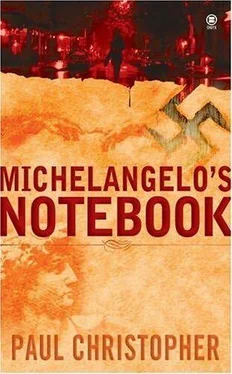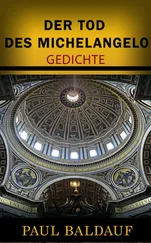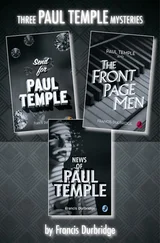Paul Christopher - Michelangelo_s Notebook
Здесь есть возможность читать онлайн «Paul Christopher - Michelangelo_s Notebook» весь текст электронной книги совершенно бесплатно (целиком полную версию без сокращений). В некоторых случаях можно слушать аудио, скачать через торрент в формате fb2 и присутствует краткое содержание. Жанр: Триллер, на английском языке. Описание произведения, (предисловие) а так же отзывы посетителей доступны на портале библиотеки ЛибКат.
- Название:Michelangelo_s Notebook
- Автор:
- Жанр:
- Год:неизвестен
- ISBN:нет данных
- Рейтинг книги:5 / 5. Голосов: 1
-
Избранное:Добавить в избранное
- Отзывы:
-
Ваша оценка:
- 100
- 1
- 2
- 3
- 4
- 5
Michelangelo_s Notebook: краткое содержание, описание и аннотация
Предлагаем к чтению аннотацию, описание, краткое содержание или предисловие (зависит от того, что написал сам автор книги «Michelangelo_s Notebook»). Если вы не нашли необходимую информацию о книге — напишите в комментариях, мы постараемся отыскать её.
Michelangelo_s Notebook — читать онлайн бесплатно полную книгу (весь текст) целиком
Ниже представлен текст книги, разбитый по страницам. Система сохранения места последней прочитанной страницы, позволяет с удобством читать онлайн бесплатно книгу «Michelangelo_s Notebook», без необходимости каждый раз заново искать на чём Вы остановились. Поставьте закладку, и сможете в любой момент перейти на страницу, на которой закончили чтение.
Интервал:
Закладка:
“But it grew into something else.”
“Yes. By the early nineteen hundreds with the first graduating class, it turned into a benevolent society, like Skull and Bones at Yale. If you were a banker, you lent money to a fellow member in real estate. If you were in government, you passed laws that would help a member expand his business.”
“An early form of good-old-boys networking,” said Finn.
“Something like that.” Kornitzer paused. “In the end it was the twelve members of the original club who bought the school out of bankruptcy during the Depression. For some reason they decided to go underground just after World War Two-that’s your Delaware corporation. They used the firm of their lawyers to buy up a shell company that also owned an entity called the McSkimming Art Trust in Chicago. They changed the name to the Grange Foundation, which has offices here in New York. St. Luke’s Place in Greenwich Village.”
“What do they do?”
“Nothing, apparently. They have no legal mandate: It’s a private trust. It doesn’t have to make any kind of report except to the IRS. According to their tax records they’re a nonprofit organization that facilitates museum and gallery research into particular works of art and artists. What they really are is an art agency. As far as MAGIC can tell they have several major clients, in particular the archdiocese of New York and the Parker-Hale Museum of Art. From what MAGIC tells me, nearly every transaction has been handled commercially by the Hoffman Gallery, which has its head office in Berne, Switzerland.”
“We’re getting closer.”
“Closer still. Your James Cornwall was a member in good standing of Carduss before the war. So was Gatty, so was a man named McPhail. Cornwall and McPhail were officers in G5, which in turn was a division of the OSS, the Office of Strategic Services. They were part of a group of art specialists attached to the Monuments, Fine Arts and Archives unit in Germany at the end of the war.”
“And Gatty was the OSS liaison in Switzerland, working for Dulles.”
“It gets better. According to MAGIC there’s a clear line of documentation in OSS records that shows that Gatty organized the movement of Cornwall and his men through the so-called Vatican ‘ratline.’ He also got them transportation out of Italy through the port of Sestri Ponente just outside of Genoa. The Bacinin Padre, which was renamed the USS Swivel. You can trace them all the way to an address on Hudson Street and a company called American Mercantile.”
“This is getting very strange,” said Finn.
“American Mercantile went belly-up in 1934. They made work clothes. The building was empty from then on. The real estate company leased it out as warehouse space.” He grinned. “Ask me the address on Hudson Street.”
“I’ll bite. What was the address?”
“Four twenty-one. It’s a condo building now, but it’s right across the street from James J. Walker Park. Eight-story Italianate. Fancy for a commercial building. Built in the 1800s.”
“I don’t get it,” said Finn. “Why is that important?”
“Because the street that looks into the park from the south side is St. Luke’s Place-home of the Grange Foundation. It can’t be a coincidence,” said Valentine.
“It’s not,” said Kornitzer. He punched a key and stared at the computer screen. “The United States Quartermaster Department Archives show that the shipment underwritten by Gatty turned up at 421 Hudson and was stored on the main floor of the building, sealed and under guard for eighteen days from July 27 to August 15, 1945. On August 16, 1945 the guards were removed. There’s no record of the shipment after that.” He paused again. “Whatever Gatty had shipped for Cornwall just vanished.”
“How big was the shipment?”
“Two hundred twenty-seven tons. Assorted crates and boxes.”
“Two hundred twenty-seven tons of what?” asked Finn.
“It doesn’t say.” The pudgy hacker shrugged. “The records of the group passing through the Vatican ratlines mentions six sealed trucks traveling through Switzerland into Italy, then down the coast to Genoa, that’s all.”
“It’s the Gold Train,” Valentine murmured.
“What’s that?” Finn asked.
“It’s one of those World War Two stories nobody quite believes,” he explained. “A book came out about it a couple of years ago. According to the book a shipment of looted treasure was put onto a train out of Budapest right at the end of the war by a man named Arpad Toldi, the SS Commissioner of Jewish Affairs in Hungary. He made sure there was no inventory made of the material on the train-three or four billion dollars’ worth of gold-and sent the train off to Germany. It never got there. It fell into the hands of the U.S. Army.”
“Then what happened?” Finn asked.
“It disappeared,” said Valentine. “Just like Cornwall’s six truckloads. It’s all part of that World War Two Nazi-treasure mythology. Nothing’s ever been proven.”
“There’s more,” said Kornitzer.
“Tell me.”
“You remember the name Licio Gelli?”
“The man who was involved in the Vatican Bank scandal. Some kind of backroom boy.”
Kornitzer checked the screen, chewing on the end of a pencil now. “His name’s all over the Vatican documentation. A direct link with Dulles as well. Something called Operation ‘Left Behind.’ Among other things Gelli was helping Nazis get out of town back in 1945. The later stuff relates to something called Propaganda Due, P2, some kind of neo-fascist group in the Vatican. It fits.”
After World War II, the race was on between the Soviet and western blocs to apprehend Nazi war criminals, or recruit intelligence and other assets. The Vatican used its resources to provide passports, money and other support for church-run underground railroads that transported former Nazis and supporters out of Europe to safer havens in the Middle East, Britain, Canada, Australia, New Zealand, the United States and South America. Organizations like ODESSA (Organization of Former Officers of the SS) and Der Spinne, “The Spider,” took advantage of this service. By some accounts the Vatican ratline provided support to as many as 30,000 Nazis. Among the beneficiaries of the Holy See’s largesse were former Gestapo operative Klaus Barbie; Adolph Eichmann; Dr. Joseph Mengele, the “White Angel” or “Angel of Death” of the Auschwitz death camp; Gustav Wagner, deputy commander of the Sobibor camp; and Franz Stangl of the Treblinka extermination facility. Members of the Waffen SS “Galician Division” were resettled as well.
“Where’s Gelli now?”
“He died in jail. Heart attack. A lot of people say he was killed by an overdose of digitalis, just like Pope John.”
“It sounds like we’re moving into Dan Brown territory here: weird cults, Catholic conspiracies, Leonardo da Vinci painting in code. Sounds like a lot of white supremacist David Duke twaddle to me.”
“Call it what you want, but there’s something running all through this information like a thread you can’t quite see, that even MAGIC can’t cut through, and that’s saying something, believe me.”
“Give me your best guess.”
“I don’t have one. There’s not enough to go on except for this strange kind of itch, the kind you can’t quite get at. Something else going on, something underneath all the other stuff.”
“It’s the killer,” said Finn, suddenly seeing it all. The whys and the wherefores could sort themselves out later, but beyond a shadow of a doubt she knew that Kornitzer’s itch, the thread running through everything they’d uncovered was the identity of the killer.
“Explain that,” said Valentine.
“I can’t, not really. But I’ll bet if you looked hard enough, looked at the names of all these people, you’d find more deaths, killings. Somehow he knew about the Michelangelo, knew about Crawley firing me, knew that it might start a chain of events that would lead to his being discovered, and that’s why Peter died. It was supposed to be me.”
Читать дальшеИнтервал:
Закладка:
Похожие книги на «Michelangelo_s Notebook»
Представляем Вашему вниманию похожие книги на «Michelangelo_s Notebook» списком для выбора. Мы отобрали схожую по названию и смыслу литературу в надежде предоставить читателям больше вариантов отыскать новые, интересные, ещё непрочитанные произведения.
Обсуждение, отзывы о книге «Michelangelo_s Notebook» и просто собственные мнения читателей. Оставьте ваши комментарии, напишите, что Вы думаете о произведении, его смысле или главных героях. Укажите что конкретно понравилось, а что нет, и почему Вы так считаете.











